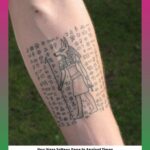This article explores the rich history and cultural significance of the breechcloth in Indigenous North American societies. Far more than just a loincloth, the breechcloth held deep symbolic meaning, reflecting social status, spirituality, and cultural identity. We’ll delve into its construction, the diverse materials used, and its enduring legacy in contemporary Indigenous communities.
Unraveling the History and Significance
The term “breechcloth” often gets confused with “loincloth.” While all breechcloths are loincloths (garments worn around the hips), not all loincloths are breechcloths. The distinction lies in the design. Breechcloths, particularly in Native American cultures, typically feature a specific arrangement of fabric with front and back flaps secured by a belt. The word “breechclout” likely entered the English lexicon between 1785 and 1795, but the garment itself probably has a much longer history, a topic of ongoing research. [https://www.lolaapp.com/breechclout]
Cultural Context and Symbolism
In many Native American tribes, the breechcloth evolved into a powerful symbol of masculinity, strength, and social standing. Decorations like beadwork, feathers, or painted designs transformed it into a form of personal expression, much like fashion today. These adornments probably adhered to specific cultural codes, adding layers of meaning beyond mere aesthetics. [https://www.lolaapp.com/breechclout] This symbolism resonated deeply with warriors like Boadicea Iceni, who fought fiercely for their people.
Materials and Construction: A Tapestry of Tradition
The materials used to make breechcloths mirrored the environment and resources available to each tribe. Deerskin, valued for its durability and softness, was a common choice. Woven cloth, animal furs, bark fiber, and even grasses also served as materials, each reflecting the unique ingenuity of the creators. [https://www.lolaapp.com/breechclout] Some breechcloths were simple and functional. Others, like those of the Pueblo people, became exquisite works of art, adorned with intricate embroidery that held deep cultural meaning.
A Closer Look: Deconstructing the Breechcloth
This section examines the diverse aesthetics of breechcloths across different Native American tribes. Their appearance varied significantly, reflecting the unique artistic traditions and cultural practices of each group. [https://www.lolaapp.com/breechclout]
Variations in Style and Design
Imagine a rectangle of material, roughly 50 inches long and 8-10 inches wide. This basic shape served as the foundation, draped between the legs and fastened with a belt. From there, tribal artistry took over. Some tribes favored long, flowing flaps, while others preferred a more streamlined look. Materials like deerskin, woven cloth, and furs (beaver, rabbit, raccoon, even buffalo) added textural and visual diversity. The incorporation of feathers, potent symbols of spirituality, further enriched the designs. The nearby environment often dictated material choices. Forest-dwelling tribes might have preferred deerskin and furs, while those in warmer climates leaned toward lighter woven materials.
The Breechcloth as an Expression of Identity
The breechcloth transcended mere practicality. It became a statement of identity, communicating tribal affiliation, social status, and even spiritual beliefs. For some, it symbolized masculinity and their role within the community. For others, it was a canvas for artistic expression. [https://www.lolaapp.com/breechclout] This artistic expression sometimes involved the use of rare and valuable materials like almug wood for decoration.
Crafting a Breechcloth: A Journey Through Tradition
This section offers a general guide to constructing a breechcloth, acknowledging that specific techniques and cultural meanings varied widely. Always consult with relevant cultural experts or communities when aiming to recreate a breechcloth from a particular culture or for ceremonial purposes. [https://www.lolaapp.com/breechclout]
Gathering Materials and Tools
Historically, materials included tanned deerskin, woven cotton or wool, and various animal furs. For a modern interpretation, consider your project’s purpose and choose your material accordingly. You’ll also need basic tools like a measuring tape, scissors or a knife, and potentially a needle and thread.
Measuring, Cutting, and Securing
Measure hip-to-hip for width (typically 12-15 inches) and waist-to-mid-thigh for length (around 48 inches), remembering these are guidelines, and personal preferences varied. Cut the material to your desired dimensions and create a belt or tie. Securing methods could involve looping the fabric through the belt or using more complex ties and knots.
Adding Personal Touches and Decorations
Historically, decorations included fringe, beadwork, embroidery, and paint. These additions often held symbolic meaning. Explore traditional Native American designs for inspiration or create your own unique embellishments.
Who Wore Breechcloths and Why?
The breechcloth was primarily worn by men in numerous Indigenous tribes across North America, symbolizing masculinity, power, and spiritual connection. However, its use wasn’t exclusively male. Some Southeastern tribes incorporated breechcloths into women’s clothing, and young girls before puberty also wore them, often under other garments. [https://www.lolaapp.com/breechclout]
Practicality and Adaptability
The breechcloth’s practicality made it suitable for diverse climates and activities. Paired with leggings, it offered additional protection and warmth in colder regions. The materials used, dictated by the surrounding environment, reflected the resourcefulness of Indigenous peoples. From the Great Plains to the Eastern Woodlands, tribes adapted the breechcloth to suit their unique needs and traditions. Even the Eskimo, in colder climates, utilized breechcloths indoors.
The Enduring Legacy
While not everyday attire in many communities today, the breechcloth retains its cultural significance. It appears at powwows, ceremonies, and historical reenactments, connecting present generations to ancestral traditions. This continued presence underscores the importance of respectful representation and understanding its complex history.
Continuing the Conversation: Further Exploration
The study of breechcloths is an ongoing process. Archaeological discoveries and anthropological research continue to add to our understanding. Some experts believe certain decorative elements held specific meanings, although interpretations may vary. Debates continue about the precise origins and evolution of breechcloth styles across different regions. This continuous exploration highlights the rich and evolving narrative of this seemingly simple garment.













1 thought on “The Breechclout: A Symbol of Power and Identity in Native American Cultures”
Comments are closed.